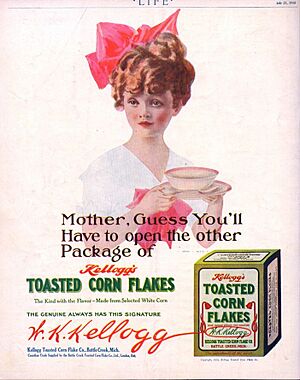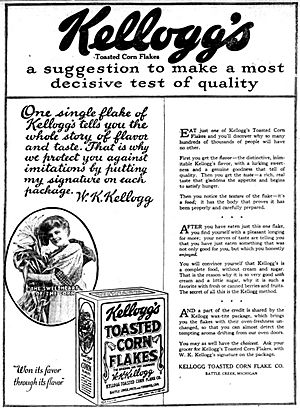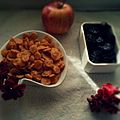Corn flakes facts for kids

Corn flakes
|
|
| Place of origin | United States |
|---|---|
| Region or state | Battle Creek Sanitarium in Michigan |
| Created by | John Harvey Kellogg (1894) W.K. Kellogg |
| Main ingredients | Milled corn, sugar, malt flavoring |
| Variations | multiple |
Corn flakes are a super popular breakfast cereal made from toasted flakes of corn. They were first made by John Harvey Kellogg in 1894. He thought they would be a healthy food for people at the Battle Creek Sanitarium in Michigan, where he worked. The patients loved them!
Soon, the Kellogg Company was started to make corn flakes for everyone. A special paper called a patent was given in 1896 for how to make them. Later, another person named C. W. Post started making similar cereals. Kellogg kept trying new things and added different ingredients. In 1928, he even started making Rice Krispies, which also became very popular.
Many companies make their own versions of corn flakes. Besides eating them for breakfast, crushed corn flakes can be used in cooking. They can replace bread crumbs in recipes and are used in many yummy dishes.
Contents
What are Corn Flakes?
Corn flakes are a packaged cereal. They are small, toasted flakes of corn. People usually eat them cold with milk and sometimes sugar. When they were first made, they were plain. But now, they often have salt, sugar, and malt for extra flavor.
Many new kinds of corn flakes have been made over the years. Some popular ones include sugar frosted flakes and honey & nut corn flakes. The biggest cereal factory in the world, located in Trafford Park in England, makes a lot of corn flakes!
How Corn Flakes Were Invented
The story of corn flakes began a long time ago, in the late 1800s. A group of people called Seventh-day Adventists were trying to create new foods. They wanted to follow a vegetarian diet, which their church suggested. They tried many different grains like wheat, oats, rice, barley, and corn.
In 1894, John Harvey Kellogg was in charge of the Battle Creek Sanitarium in Michigan. He was an Adventist. He used these new food ideas as part of a special diet for his patients. This diet was very strict. It meant no alcohol, tobacco, or caffeine. The food was also very plain.
The idea for corn flakes actually happened by accident! John Kellogg and his younger brother, Will Keith Kellogg, were working at the sanitarium. They left some cooked wheat out for a while. When they came back, the wheat had gone a bit stale. But they didn't want to waste it because they had a tight budget.
So, they decided to push the stale wheat through rollers. They hoped to get long sheets of dough. But to their surprise, they got flakes instead! They toasted these flakes and served them to their patients. This happened on August 8, 1894. They later got a patent for their "Flaked Cereals" on April 14, 1896.
The patients loved these grain flakes, which the Kellogg brothers called granose. The brothers then tried making flakes from other grains too. In 1906, Will Keith Kellogg, who managed the business side, decided to sell the new food to everyone. He started his own company, the Battle Creek Toasted Corn Flake Company. He added sugar to the flakes to make them taste even better for a wider audience.
Will Kellogg also kept trying out new cereals. Rice Krispies, his next big success, first came out in 1928.
Corn Flakes Mascots
Kellogg's Corn Flakes have had many mascots. The most famous one is a green rooster named Cornelius "Corny" Rooster. He has been the mascot for a long time. In early TV ads, he would say, "Wake up, up, up to Kellogg's Cornflakes!" Two voice actors, Dallas McKennon and Andy Devine, voiced him. Later, he stopped talking and just crowed.
The idea for using a rooster came from a family friend from Wales. In the Welsh language, the word for rooster is ceiliog (pronounced keyeleeog or keelog).
Other Corn Flake Brands
C. W. Post, who used to be a patient at the Battle Creek Sanitarium, started his own company. He made a rival brand of corn flakes in the United States called Post Toasties. In Australia, a company called Sanitarium Health and Wellbeing also makes its own corn flakes called Skippy corn flakes. Many other companies make their own versions of corn flakes too.
Corn Flakes in Cooking
There are many different recipes that use corn flakes. Crushed corn flakes can even be used instead of bread crumbs in some dishes.
Honey joys are a popular party snack in Australia. They are made by mixing corn flakes with honey, butter, and sugar. Then they are baked in small paper cases or muffin cups. In the UK, a similar treat is chocolate corn flake cakes. These are made with corn flakes, dark chocolate, golden syrup, and butter. In New Zealand, corn flakes are a main ingredient in Afghan biscuits. These are chocolate cookies made with corn flakes and topped with chocolate icing.
Images for kids
See also
 In Spanish: Corn flakes para niños
In Spanish: Corn flakes para niños









